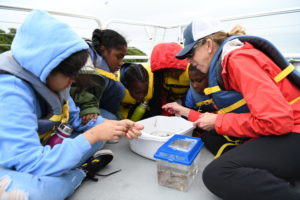|
Getting your Trinity Audio player ready...
|

It may be Miami’s fourth graders who wind up restoring Biscayne Bay. Blue Scholars Initiative, a new marine conservation education program, is offering fourth grade public school students the opportunity to learn the marine science of the pollution-threatened Bay.
The initiative, registered as a 501(C)(3) organization, teaches the youngsters a virtual marine science program via computers, in-classroom, and boat trips on the Bay. Children from these Title I schools might otherwise never have the chance to connect with the marine environment.
Blue Scholars engages students in marine biology, ecology and watershed concepts, demonstrating the impacts caused by humans. In the classroom, along the shoreline and from boats, students investigate the rich biodiversity of the ocean, conduct citizen science, and develop a passion for the environment, thus inspiring the next generation of ocean stewards.
Blue Scholars also Blue Scholars Initiative hosts a number of public programs and events throughout the year in concert with other non-profit organizations focused on protecting the environment and marine education. These include beach cleanups, tree plantings and awareness events which shine the spotlight on the importance of protecting the ocean.
Blue Scholars was founded in 2019 by South Florida natives and environmentalists Adam Steckley, Meredith Bass and Doug Brown.
Schools being served by Blue Scholars include Meadowlane Elementary, Palm Lake Elementary, The Home, Leewood K-8 Center, Dr. William A. Chapman Elementary, Henry S. West Laboratory School, Miami Beach South Pointe Elementary, Overtown Youth Center, Overtown Optimist Club, Breakthrough Miami and The Home Team.
During the Pandemic, Blue Scholars offered daily virtual marine science education to fourth graders in 60-minute lessons, which are aligned to the State of Florida Next Generation Sunshine State Standards for Science.
Students embark on pontoon vessels from marinas on north, south and central Biscayne Bay, study the marine environment up close, the marine food chain, photosynthesis and the importance of the mangrove and seagrass nurseries. They also watch pelicans diving for fish, dolphins and sea turtles surfacing for air, and eagle rays gliding across the shallow grass meadows.
Climate Change and sea level rise are also discussed, and the students learn of the importance of water quality in sustaining marine life. The children take water samples and identify temperature, pH, salinity, dissolved oxygen and turbidity. Miami’s downtown skyline serves as a backdrop to every lesson on the water, ever reminding students of the influences of human development and resulting pressure on the Bay and its environment.





